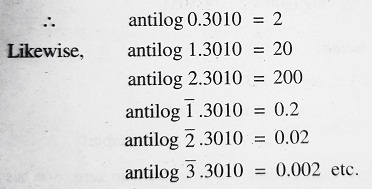Characteristic and Mantissa of a Logarithm:
It is obvious that if x < y, then 10x < 10y. Conversely, if 10x < 10y, then x < y. Now, let 10x = p and 10y = q, so that paying attention to common logarithms, we have, x = log p and y = log q.
Now, if 10x < 10y i.e., if p < q, then x < y i.e., log p < log q.
Now, if 1 ≤ x < 10, then, log 1 ≤ log x < log 10 ⇒ 0 ≤ log x < 1.
Hence, if x lies between 1 and 10, then log x lies between 0 and 1.
Let us now consider the number 3456. It can be written as a power of 10 in the form of 3.456 x 103. Similarly, 0.0123 can be written as 1.23 x 10-2 (simply by shifting the decimal 2 places to the right). In general, any number p can be written as x . 10n, where 1 ≤ x < 10 and n is an integer. This form of a number is known as its standard form.
| Thus, p = x . 10n ∴ log p = log x + nlog 10 = n + log x, (∵ log 10 = 1) where n ∈ I. |
The integral part n of log p is called the characteristic of log p and log x is called its mantissa.
As 0 ≤ log x < 1, the mantissa of a logarithm is its fractional part.
| Let us take the number 125. Here, 102 < 125 < 103. ∴ log 125 = 2 + a positive fraction. Hence, 2 is the characteristic of log 125. Again, 0.03 > 10-2 but < 10-1 ∴ log 0.03 = -2 + a positive fraction. Thus, the characteristic of the logarithm of a number may be positive or negative but the mantissa is always positive. |
Logarithms are always written with the decimal part positive.
The steps to find out the logarithm of a number are given below:
(1) Firstly, one has to find the characteristic in the logarithm of the number. It is better to remember that the characteristic in the logarithm of any number greater than unity is positive and 1 less than the number of digits in an integral part of the number. The characteristic of any positive number less than unity is negative (denoted by a bar) and is numerically one greater than the number of zeros immediately after the decimal point of the number.
(2) Secondly, one has to determine the mantissa in the logarithm of the number. To do so, disregarding the decimal point of the number, one has to locate the first two significant digits from the extreme left-hand column of the logarithmic tables. If the given number has only one digit, one has to replace it with a two-digit number obtained by adding zero to the right of the number. Thus, 3 is to be replaced by 30 in order to find the mantissa.
For the third digit in the number whose logarithm is being found out, the entry in the row obtained above is located in the respective column of the same row in the logarithm table.
For the fourth digit of the number, the corresponding entry in the table of proportional parts (called the Mean Difference Column) is located and is added to the entry obtained earlier.

Antilogarithm- The very word anti means the reverse of some operation. Hence, if log M = x, then antilog x = M.
We have, log 2 = 0.3010

To determine the antilogarithm of a number, the steps to be followed are-
- Consider the number in the decimal part disregarding the characteristic.
- Locate the row consisting of the first two digits of the number after the decimal place in the extreme left column of the antilogarithm table.
- Note the entry of the column headed by the third digit after the decimal place that belongs to the same row.
- Add the mean difference for the fourth digit from the same row to the number obtained.
- Finally, Insert the decimal after the appropriate number of digits of the number thus obtained, following the rules of characteristic.









Comments (No)